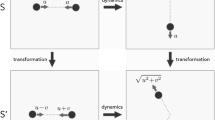Abstract
I derive from the Palatini formalism, in which metric and affinity are varied independently, an energy-momentum complex qualitatively different in form from the usual energy-momentum representations of general relativity. A similar procedure can be carried out for electrodynamics, illuminating by analogy the structure of the gravitational Lagrangian. The new energy density vanishes for all static vacuum solutions of the Einstein equations, and the radiated energy from an isolated system in an asymptotically flat space in general diverges. These facts suggest that the formalism could be used to express Mach's principle.
Similar content being viewed by others
References
Arnowitt, R., Deser, S., and Misner, C. W. (1962). InGravitation: An Introduction to Current Research, L. Witten, ed., Wiley, New York, Chapter 7.
Einstein, A. (1916).Sitzungberichte der Preussiche Akademie der Wisseschaften,1916, 1115 [Reprinted in A. Einsteinet al, The Principle of Relativity, Dover, New York].
Einstein, A. (1955).The Meaning of Relativity, 5th ed., Princeton University Press, Princeton, New Jersey.
Lorentz, H. A. (1916).Versl. gewone. Vergab. Akad. Amst.,25, 468, 1380.
Mach, E. (1893).The Science of Mechanics, 2d English ed., Open Court, Chicago, pp. 226–232.
Misner, C. W., Thorne, K. S., and Wheeler, J. A. (1973).Gravitation, Freeman, San Francisco, Chapter 35.
MØller, C. (1972).The Theory of Relativity, 2d ed., Oxford University Press, Oxford, pp. 459–474.
Murphy, G. L. (1976).Australian Journal of Physics,29, 469.
Palatini, A. (1919).Rend. Circ. Mat. Palermo,43, 203.
Pauli, W. (1958).Theory of Relativity, Pergamon, New York, pp. 176–177.
Sachs, R. K. (1967). Gravitational waves, inRelativity Theory and Astrophysics, J. Ehlers, ed., American Mathematical Society, Providence, Rhode Island.
Schrödinger, E. (1950).Space-Time Structure, Cambridge University Press, Cambridge, Chapter XI.
Sciama, D. W. (1959).The Unity of the Universe, Doubleday, Garden City, New York.
Weisskopf, V. S. (1939).Physical Review,56, 72.
Weyl, H. (1922).Space-Time-Matter, Dover, New York, Section 33.
Wheeler, J. A. (1962).Geometrodynamics, Academic Press, New York, pp. 58–63.
Author information
Authors and Affiliations
Rights and permissions
About this article
Cite this article
Murphy, G.L. Energy and momentum from the Palatini formalism. Int J Theor Phys 29, 1003–1009 (1990). https://doi.org/10.1007/BF00673686
Received:
Issue Date:
DOI: https://doi.org/10.1007/BF00673686




